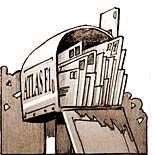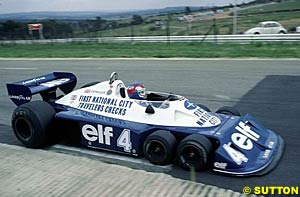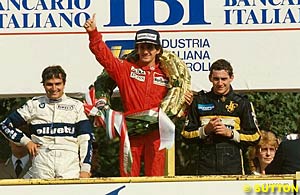
Atlas F1 Magazine Writer

Have a question about Formula One statistics or history? Well you're not the only one, and it's about time someone came up with the answers to F1's most Frequently Asked Questions. Send us your questions to faq@atlasf1.com - we may not know everything, but we'll do our best to find out
The big sponsors make up the major part of this puzzle. Williams used Renault engines from 1989 until 1997. Barclay was a main sponsor from 1987 until 1990, which limits the search to just two years: 1989 or 1990. However, in 1990 beer company Labatt's became a significant sponsor too. This mean we can safely assume that your set of overalls are from the 1989 season.
It is named after the address where the FIA headquarters are: 8, Place de la Concorde in Paris, France.
Quite a bit of activity there, isn't it? Well, let's see who does what and do a headcount based on that. First of all, there's three guys for each wheel: one to screw the old wheel loose and new one on, one to put on the new wheel and one to take care of the old wheel. Four wheels make 12 people just for that. Then there's the refueling. One guy to put the hose in and one guy behind him to keep the hose up over his shoulder. Another two guys on the jacks: one in front and one behind. Of course there's the lollypop man, who has to give the driver the sign of when to do what.
These days, with the exhausts coming out in the top of the body work, there's also a guy with a separator on a stick to make sure that any spilt fuel cannot reach the exhausts and cause the car to burst in flames. This makes a grand total of 18 people who are involved in every single pitstop.
You can also see a graphical display of a typical pitstop in Atlas F1's archives, at http://www.atlasf1.com/2002/eur/tech.html.
However, there have been more cars with six wheels. Williams made a six wheeler with four of the wheels at the rear. This was in late 1981 and was driven by Alan Jones and Keke Rosberg. March also built a six wheeled car, but used it mainly to attract sponsors. This was around the same time Tyrrell raced theirs.
Finally, there's the Ferrari six wheeler, which was tested by Niki Lauda and Carlos Reutemann in 1977. This one was different than the others in the way that it didn't feature two small wheels shortly behind each other, but two full size wheels next to eachother.
The official statement of the FIA World Motor Sport Council on 11 November 1997 said the following:
"The World Council decided to exclude Michael Schumacher from the results of the 1997 FIA Formula One World Championship for drivers. The final results of the FIA Formula One World Championship have been modified accordingly. The results of the Constructors' Championship remain unchanged. Michael Schumacher retains his points and victories recorded during the 1997 season."
This means that effectively the only punishment Michael Schumacher received was to see his name scratched off from the 1997 Drivers' Championship. Otherwise, all his results and points in 1997 count towards his career total.
Article 4.1 of the technical regulations deal with the weight of the cars. It says the weight of the car must not be less than 605kg during each qualifying practice session and no less than 600kg at all other times during the Grand Prix weekend, race included.
The exact definition of weight is in article 1.9: "Is the weight of the car with the driver, wearing his complete racing apparel, at all times during the event."
Article 9.3 deals with the gears. It states a Formula One car can have no less than four forward gears and no more than seven.
As mentioned in a previous F1 FAQ, the laurel wreath disappeared gradually during the 1980s. Meanwhile, I've seen a few more photographs and the latest I've found now would be the 1985 Italian Grand Prix, where Alain Prost was presented with the laurel wreath after winning the race.
The oldest driver to start his first World Championship Formula One race was Arthur Legat, who claims the title of oldest rookie. This Belgian garage owner competed in his home Grand Prix in 1952 at the age of 53 years, 7 months and 21 days, and finished the race in 13th position.
If we define modern day as any race from 1970 onwards, the honour goes to Carlo Franchi who competed in the 1978 Italian Grand Prix aged 40 years, 8 months and 9 days. He didn't actually race on Sunday, though, since he didn't qualify his Surtees.
If we're looking for the oldest driver to have actually raced in his debut Grand Prix since 1970, we arrive at George Follmer. This American was hired by Shadow to drive alongside Jackie Oliver in the 1973 season. At the time of his debut, Follmer was 39 years, 1 month and 4 days.
If we limit outselves to drivers who made their debut in the last ten years, Toshio Suzuki - not to be confused with fellow Japanese Aguri Suzuki - took the start of the 1993 Japanese Grand Prix at the age of 38 years, 7 months and 14 days. Suzuki, who is a very experienced sportscar racer in his home country, replaced Frenchman Philippe Alliot for the final two races of the 1993 season.
"I'm trying to identify a set of overalls I acquired a few years ago. I am hoping this is possible from the sponsors. So, in what year were the following sponsors of Williams F1? Renault, Elf, Canon, Denim, Goodyear, Barclay, Calma, ICI. Overalls colours were Navy blue, yellow, red. I think it's 1992! Thanks, David"
"Why is the regulatory agreement for F1 known as the Concorde Agreement? Mike"
"How many people are in the pitstop crew of Ferrari in F1? Nicky"
"Who made a 6-wheel F1 car that was driven by Niki Lauda in the early to mid 70s? Beeg"
 The most well known six wheeler is the Tyrrell P34. This car competed in 1976 and 1977, and part of its legendary status is down to the fact that it won its third race out. In its first season it was driven by Jody Scheckter and Patrick Depailler and in its second season Depailler was replaced by Ronnie Peterson. This was in fact the only six wheeler to start a World Championship Grand Prix.
The most well known six wheeler is the Tyrrell P34. This car competed in 1976 and 1977, and part of its legendary status is down to the fact that it won its third race out. In its first season it was driven by Jody Scheckter and Patrick Depailler and in its second season Depailler was replaced by Ronnie Peterson. This was in fact the only six wheeler to start a World Championship Grand Prix.
"When Michael Schumacher was disqualified from the 1997 season, how much of his results counted and do current statistics show his results ? Thanks Sean"
"Hi, Just wanna know about: 1) minimum weight of an F1 car. 2) maximum number of forward gears of an F1 car? Thanx a lot! Noorazlina"

"Could you tell me when, in the history of Formula One, was the last traditional laurel wreath for the podium celebrations? Who was the driver to get it? What year? Jose"
"who was the oldest driver to enter Formula One in the modern era? Thanks very much, Jonathan"
Please Contact Us for permission to republish this or any other material from Atlas F1.
|
Volume 9, Issue 19
Atlas F1 Special
View from the Paddock: Special Edition
Lost Weekend: Interview with Pizzonia
Renault to the Fore
Spanish Moss
Spanish GP Review
2003 Spanish GP Review
Technical Review: Spanish GP
Racers or Timeservers?
The Reign in Spain
Stats Center
Qualifying Differentials
SuperStats
Charts Center
Columns
Season Strokes
F1 FAQ
Elsewhere in Racing
The Weekly Grapevine
> Homepage |